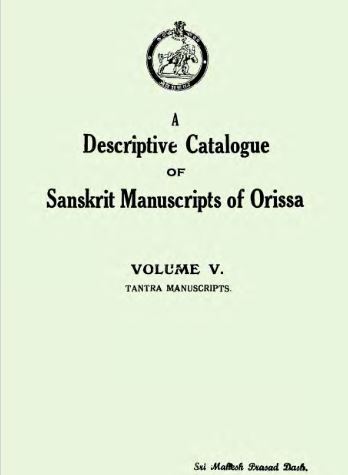Authored by Mahes Prasad Das and published in 1965, “A Descriptive Catalogue of Sanskrit Manuscripts of Orissa, v.05,” is an invaluable resource for scholars and enthusiasts of ancient Indian literature, particularly those with a focus on the region of Odisha (formerly Orissa) and its rich Sanskrit heritage. This volume forms part of a larger series that meticulously catalogues the wealth of Sanskrit manuscripts discovered in Odisha, providing detailed descriptions that are crucial for the understanding and preservation of these cultural treasures.
The book opens with an introduction to the historical and cultural context of Odisha, a state renowned for its contributions to Indian philosophy, art, and literature. Known as Kalinga in ancient times, this region has been a melting pot of religious and philosophical ideas, including the Vedic, Puranic, and Tantric traditions. The compendium underscores the significant role Odisha played as a center of learning and a custodian of Sanskrit manuscripts.
Central to the volume is its emphasis on the diversity of manuscripts it describes, encapsulating a variety of genres including Vedic texts, Tantric scriptures, Puranas, and various classical works on philosophy, astronomy, medicine, grammar, and poetry. This fifth volume pays particular attention to Tantric manuscripts, shedding light on a less explored but profoundly important aspect of Indian spirituality and esoteric tradition.
Tantra, historically shrouded in mystery and often misunderstood, is systematically presented through the meticulous descriptions and analyses of the manuscripts. These texts cover a spectrum of subjects within Tantra, ranging from rituals, sadhanas (spiritual practices), cosmology, to the intricate symbolism that defines Tantric thought. Das provides not only an inventory of the manuscripts but also critical insights into their content, historical lineage, and the scribes who copied them, offering a rare window into the world of ancient scriptoria and libraries of Odisha.
The cataloging process adopted by Das reflects rigorous scholarly standards. Each manuscript entry includes details such as the title, dimensions, material (palm leaf or paper), script used (chiefly Devanagari or Oriya), condition, provenance, colophons, and the number of folios. Descriptive notes enrich the entries with summaries of the text’s content, thematic importance, and cross-references to other related works. This systematic approach makes the volume an indispensable reference for further academic research, comparative studies, and critical editions of Sanskrit texts.
One of the book’s notable features is its inclusion of rare and unique manuscripts that are not available elsewhere, ensuring that the catalog preserves knowledge that might otherwise have been lost. The annotations also highlight inter-regional connections, pointing to how these manuscripts traveled and influenced various parts of India and beyond.
The publication of “A Descriptive Catalogue of Sanskrit Manuscripts of Orissa, Volume 05” in 1965 was a pivotal moment for Indological studies. It has enabled deeper engagement with the intellectual heritage of Odisha and has supported the preservation and appreciation of Sanskrit manuscripts. Das’s work stands as a testament to the scholarly rigor and dedication required to unlock the vast repositories of ancient knowledge, ensuring that these timeless texts continue to inform and inspire future generations.
Books Info
| Books name | A Descriptive Catalogue of Sanskrit Manuscripts of Orissa, v.05 |
| Author | Mahes Prasad Das, C. |
| No Of pages | 237 |
| Publisher | NA |
| Publication | 1965 |
| Printed At | NA |
| Distributor | NA |
A Descriptive Catalogue of Sanskrit Manuscripts of Orissa, v.05 Sample
A Descriptive Catalogue of Sanskrit Manuscripts of Orissa, v.05 Full Pdf Download

